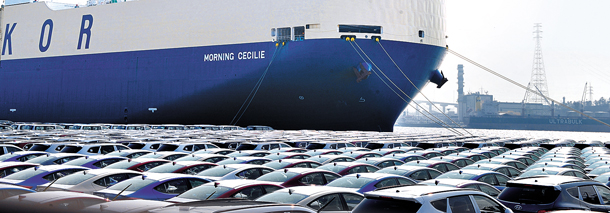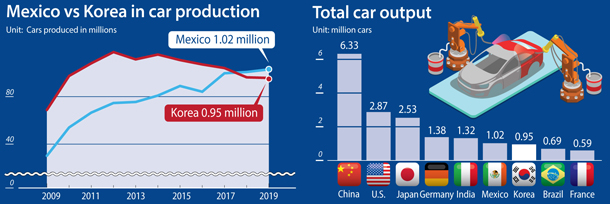Mexico overtakes Korea in vehicle production

Cars from the Hyundai Motor Ulsan plant await shipment for export. As the output of Korean cars decreased for four years in a row, Mexico’s output of cars increased. [NEWS1]
In 2018, Korea produced 4.02 million vehicles, and Mexico 4.09 million, according to Korea Automobile Manufacturers Association data released last week. It was the first time the latter beat the former.
In the first quarter of 2019, Korea produced 957,402 units, down 0.6 percent on year, and Mexico 1.02 million units, up 2.2 percent on year.
The flip has been fast and sudden.
Until 2016, Korea was the world’s No. 5 automaker. Mexico, with only 56 percent of Korea’s production at the time, was No. 7. Last year, Korea became No. 7 and Mexico No. 6.
In 2018, full year, Mexico out-produced Korea by 69,000 units. In the first three months of this year, it had already out-produced Korea by 72,000. If the trend continues, it is estimated that Mexico could make 276,000 more cars than Korea this year.

The situation at Renault Samsung Motors, while less severe, isn’t helping. The company experienced a total 62 partial strikes that shut production for 250 hours since October 2018. In the January to April period, production was down 39.8 percent on year.
SsangYong Motor’s Pyeongtaek factory, its only assembly plant in the country, is only running at 58 percent capacity despite the success of its G4 Rexton and Korando Sports models.
The combined sales volume of Hyundai Motor and Kia Motors has increased since 2017, but the focus has been on foreign factories. In the second half, when Kia Motors completes its new factory in Anantapur, India, which has an annual capacity of 300,000 units, the companies will produce more cars abroad than at home.
In a sense, the sector has been frozen for decades, since about the time of the 1997 financial crisis. No new car factory has been built in Korea in 21 years.
The last time an automaking facility was established in the country was in 1998, when Renault Samsung Motors completed its plant. Hyundai Motor built its Asan plant in 1996.
“Labor flexibility is lacking, so that is why no new automobile factories are being established in Korea,” explained the Korea Automobile Manufacturers Association (KAMA).
The trend is global, and Korea is in good company. With the world seemingly at “peak car,” production is on the decline everywhere.
The number of cars produced by the world’s top 10 car manufacturing countries in the first quarter of this year totaled 18.49 million, down 4.6 percent from last year.
Not only in Korea but also in seven other major countries, including China, the United States and Germany, output declined. China reported the sharpest fall among the top 10 countries in the first quarter of 2019, down 9.8 percent, as the demand for cars declined for nine months in a row since July 2018.
“Labor and management have to cooperate to get a competitive edge in terms of price, and the government should expand tax credits and nurture a high-quality tech workforce so that our cars in the future will be able to compete better than before,” said Jeong Man-ki, president of KAMA.
BY MOON HEE-CHUL [kim.heyu@joongang.co.kr]










with the Korea JoongAng Daily
To write comments, please log in to one of the accounts.
Standards Board Policy (0/250자)